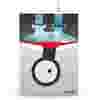What’s The Working Principle Of Gas Diaphragm Pumps And Compressors?
Diaphragm pumps, also frequently called membrane pumps, are reciprocating pumps. They are a type of positive displacement pump.
A flexible diaphragm in the pump head is moved up and down via the conrod and through the action of an eccentric on the motor shaft.
On the downstroke, the medium is drawn into the pump chamber and expelled on the upstroke. Internal valves mounted within the pump head act as check valves and control the direction of flow.




